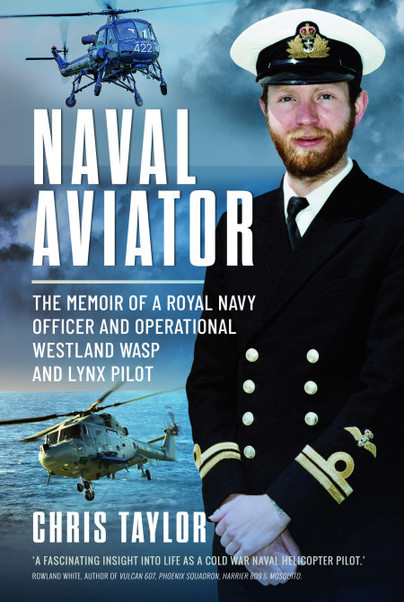
Naval Aviator. The Memoir of a Royal Navy Officer and Operational Westland Wasp and Lynx Pilot. By Chris Taylor. Published by Air World, an imprint of Pen & Sword Books, Yorkshire and Philadelphia, 2023. ISBN 978-1-39905-976-3
Reviewed by David Hobbs
Chris Taylor joined the Royal Navy in the late 1970s and this autobiographical book describes his early career including time as an officer under training in a variety of ships, flying training and several appointments as the flight commander in both Wasp and Lynx helicopter flights.
It is effectively a prequel to his two earlier books from the same publisher, Test Pilot and Experimental Test Pilot, which described his later activities. His account is detailed and written with candour, often taking the reader into his innermost thoughts which were sometimes exasperated by unwanted situations in which he found himself and sometimes full of enjoyment. There is no direct involvement with the RAN but Taylor’s description the RN small ship flight organisation makes an interesting comparison with Australian practice. The Wasp was the first manned helicopter to be operated from destroyers and frigates and by twenty-first century standards it was a crude aircraft that came very close to the limits of safe operation. Taylor went straight from flying training on the Gazelle to the Wasp at the twilight of its career. This was an unusual but not unique step as pilots converted onto the Wasp had usually completed a squadron tour on Sea Kings or Wessex.
The description of small ship helicopter operations is well structured and the descriptions of Wasp operations are the best that I have read. Taylor gives his readers an understanding of the aircraft’s strengths and many weaknesses that will interest those who have flown helicopters from ships other than aircraft carriers or been involved in any way with their operation. I have never met Taylor but many of the squadron commanding officers, ship’s captains and QHIs that appear throughout the book were my contemporaries and I found it interesting to read his opinions of men I knew as squadron friends and colleagues portrayed in a different light. His assessments were not always the same as mine. The description of ditching a Wasp on page 140 was fascinating and gives the reader an excellent idea of his thought processes and actions during this traumatic event.
The author was clearly unhappy with some of the situations in which he found himself, especially when events had not turned out as he wished them to. He admits this on page 234 when he comments that there is a danger that the reader might conclude that his overall experience of being in the RN was negative. This was not the case, he assures us; he had an equal measure of fun. The root cause of his unhappiness was the fact that he had been persuaded to join the RN through a university cadetship which committed him to a career as a seaman officer. This required him to get bridge watchkeeping and ocean navigation qualifications at an early stage when all he wanted to do was fly. He tried to change his career path but found it hard to break the assumption that he ought to be following the ship XO/command path rather than continue flying. Whilst I enjoyed reading the book, I have to comment on the author’s frequent use of words at the end of a passages of text such as ‘Yikes’, ‘Great’, ‘Bugger’ or ‘Blige’; the latter apparently a Bristol vernacular word meaning ‘Blimey’. It may be an age thing and they may appeal to a younger readership who want a lighter style of writing but they annoyed me and detracted from an otherwise good text.
Taylor served in a patrol vessel in Hong Kong as well as destroyers and frigates in both the North and South Atlantic and there are rich descriptions of periods spent on frigates acting as the Falkland Islands guardship. His descriptions of Wasp and Lynx operations give fascinating insight into an aspect of Fleet Air Arm life that has received too little historiographical attention. Hopefully Taylor’s honest and frank account will encourage others to follow his example. I recommend it and will be pleased to add it to my library of Fleet Air Arm biographical books.



